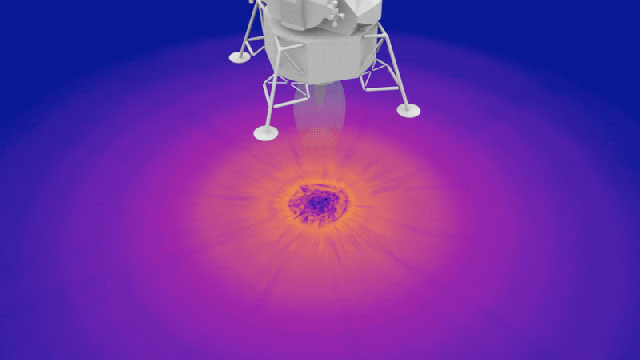The Moon is about to be a busy place, with a series of crewed missions planned by NASA as part of its Artemis program, as well as an influx of upcoming commercial landers eyeing a spot on the lunar surface. Before it sends a fleet of spacecraft to the Moon, however, NASA first wants to understand the impact these future landers might have on the lunar surface.
Using the Pleaides supercomputer at NASA’s Ames Research Center in Silicon Valley, California, engineers at the space agency developed new software tools to predict the environmental impact of engine plumes on the Moon for upcoming missions, NASA announced this week. The supercomputer created a simulation of the Apollo 12 lander touching down on the Moon’s surface on November 19, 1969.
As a spacecraft touches down on the Moon, its rocket engines are fired in order to counteract the lunar gravitational force and control its descent towards the surface. The engines blast supersonic plumes of hot gas towards the surface, kicking up dust, rock and other debris. The clouds of dust can obstruct vision, interfere with navigation and instruments on board the spacecraft, or cause damage to the lander and other nearby hardware, according to NASA. The plumes could also erode the surface of the Moon itself.
Although NASA didn’t record these hazards during the Apollo missions, the landers that are being developed for the Artemis program are larger and therefore run a greater risk of eroding the surface and possibly forming craters at the landing spot, which would jeopardize the lander’s stability.
The team used the supercomputer to visualize the Apollo 12 lander engine plumes interacting with the surface of the Moon, measuring the predicted erosion that took place during landing. The simulation runs through the last 30 seconds of descent before the engine cut off, showing the forces exerted by the plumes on a flat computational surface, according to NASA.
In the animation, the fluctuating radial patterns show the intensity of predicted shear stress, or the amount of sideways force applied over an area, with the lower shear stress highlighted in dark purple, and higher shear stress in yellow.
The new software will help improve engineers’ understanding of plume-surface interactions. “These tools are already being used to predict cratering and visual obscuration on upcoming lunar missions and are helping NASA minimize risks to spacecraft and crew during future landed missions,” NASA wrote in a statement.
